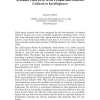26354 search results - page 62 / 5271 » How we refactor, and how we know it |
ESAW
2009
Springer
13 years 6 months ago
2009
Springer
009), which constitutes an abstraction of the various aspects of a MAS, generalizing the AGR approach and incorporating the institutional work of Searle (Searle 1995). This model i...
ACCV
2007
Springer
14 years 3 months ago
2007
Springer
This paper describes a method that accelerates pattern matching. The distance between a pattern and a window is usually close to the distance of the pattern to the adjacement windo...
FMCO
2009
Springer
13 years 6 months ago
2009
Springer
This paper reviews the model of interactive Markov chains (IMCs, for short), an extension of labelled transition systems with exponentially delayed transitions. We show that IMCs a...
EDOC
2003
IEEE
14 years 2 months ago
2003
IEEE
Distributed systems are inherently complex, and therefore difficult to design and develop. Experience shows that new technologies—such as components, aspects, and application f...
FDL
2007
IEEE
14 years 28 days ago
2007
IEEE
Transaction-level modelling (TLM) is a poorlyterm, promising a level of abstraction like RTL (register transfer level), where the key feature is a `transaction'. But unlike r...


